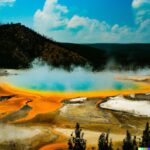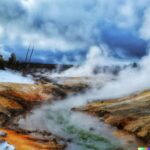Have you ever wondered what causes geysers to erupt with such power and precision? In this article, we will explore the factors that influence the eruption intervals and heights of geysers in Yellowstone National Park. From the importance of water and heat supply to the impact of human interference, we will delve into the complex workings of these natural wonders.
Join us as we uncover how scientists study geyser eruptions using monitoring equipment, field observations, and computer simulations.
What Are Geysers?
Geysers are natural geological features found in locations such as Yellowstone National Park, characterized by intermittent eruptions of hot water and steam.
These remarkable phenomena are closely linked to the geothermal activity occurring beneath the Earth’s surface. Geysers form when underground water is heated by magma, creating pressure until it erupts in a spectacular display. Factors such as the water temperature, depth, and the shape of the underground channels greatly influence the intervals between eruptions. The unique combination of these influences determines whether a geyser erupts frequently or less predictably, offering a mesmerizing glimpse into Earth’s natural forces.
What Is Yellowstone National Park?
Yellowstone National Park is a renowned national park located primarily in the U.S. state of Wyoming, known for its geothermal features, including geysers, hot springs, and thermal activity.
The stunning geothermal characteristics of Yellowstone National Park are a direct result of the park’s location atop a massive volcano. The park’s geysers, such as the famous Old Faithful, draw visitors from around the world to witness their powerful eruptions.
The variety of hot springs found in the park showcases different colors due to the presence of thermophilic bacteria, creating a vibrant display unique to Yellowstone. The thermal activity within the park not only fuels these natural wonders but also supports a diverse ecosystem that thrives in the extreme conditions.
What Are the Factors That Influence Geyser Eruption Intervals?
The intervals between geyser eruptions are influenced by a variety of factors, including geological processes, temperature fluctuations, water supply to underground chambers, and more.
Geological processes play a crucial role in determining the timing of geyser eruptions. The movement of tectonic plates can create pathways for underground water to flow and accumulate, impacting the pressure build-up necessary for an eruption. Temperature variations within the Earth’s crust can influence the heating of water in underground reservoirs, affecting the frequency and intensity of geyser activities. The availability of water supply to replenish underground chambers is also vital, as it directly influences the pressure dynamics leading to eruptions. These intertwined factors showcase the intricate balance required for the mesmerizing displays of geysers around the world.
Water Supply
The water supply to geysers plays a crucial role in determining their eruption dynamics and frequency, affected by factors such as pressure changes, geothermal reservoir conditions, and water recharge rates.
When pressure changes occur within the geothermal reservoir beneath a geyser, the built-up stress can trigger an eruption, releasing the pent-up energy explosively. The water in the reservoir acts as a key player in this process, absorbing and transferring heat from the Earth’s mantle to the surface. This transfer of thermal energy creates the conditions necessary for the geyser to erupt, showcasing the intricate relationship between water supply, pressure changes, and the underlying geothermal activity.
Heat Supply
The heat supply beneath geysers, derived from geological formations and various heat sources, influences eruption mechanisms and leads to thermal anomalies that affect the geyser activity.
This intricate interplay of heat sources and geological structures shapes the behavior of geysers in fascinating ways. The heat emanating from deep within the Earth interacts with the groundwater, creating pockets of superheated water that eventually erupt, displaying the remarkable natural spectacle that is characteristic of geysers.
The unique combination of factors, including the temperature gradient within geological formations and the presence of underground conduits, determines the frequency and intensity of geyser eruptions. These thermal anomalies provide valuable insights into the inner workings of these geological features, illustrating the dynamic relationship between heat supply and geyser activity.
Underground Plumbing System
The underground plumbing system of geysers, shaped by geological factors and vent structures, influences the eruption patterns and reflects the geologic history of the area.
The intricate network of channels and chambers within the Earth’s crust guides the flow of water and steam towards the surface, ultimately determining when and how a geyser will erupt. Vent structures play a crucial role in this process, acting as the outlet for the built-up pressure and releasing the combination of water and steam in a spectacular display. By analyzing these eruption patterns, scientists can gain insights into the underlying geologic processes and the history of seismic activity in the region.
Geological Activity
Geological activity in the vicinity of geysers, characterized by unique structures and interpretations, has significant impacts on eruption dynamics and serves as a focal point for geologic studies.
These geological structures near geysers play a crucial role in understanding the underlying processes that drive eruptions. By examining the fault lines, fractures, and rock formations in the area, geologists can uncover valuable insights into the mechanisms behind geyser activity. This in-depth analysis contributes to the broader field of geologic studies, offering a deeper understanding of how geological structures influence the behavior of geysers and their eruption patterns.
The interpretation of these structures provides a window into the geologic history of the region, shedding light on the complex interplay of forces that shape the landscape.
Human Interference
Human interference through activities such as geothermal exploration and inadequate eruption monitoring can disrupt geyser behavior, highlighting the importance of considering geologic conditions for mitigating human impacts.
When it comes to geothermal exploration, the drilling and extraction processes can alter the pressure and heat distribution beneath the surface, potentially triggering changes in geyser activity. Without proper monitoring and regulation, these human interventions may unknowingly set off a chain reaction that disturbs the delicate balance of underground water and steam.
Monitoring practices, such as real-time surveillance of geyser behavior and seismic activity, are crucial for understanding the health of these geological systems and predicting potential disruptions. By actively considering the geological conditions of geyser sites, scientists and policymakers can work towards minimizing human interference and preserving these natural wonders for future generations.
What Are the Factors That Influence Geyser Eruption Heights?
Several factors affect the heights of geyser eruptions, including seismic data analysis, the presence of steam vents, geyser activity levels, and distinctive eruption behaviors.
-
Seismic data analysis plays a crucial role in understanding the underlying dynamics that influence geyser eruption heights. By monitoring seismic signals, researchers can gain insights into the pressure buildup beneath the geyser and predict potential eruptions.
-
The presence of steam vents, which release built-up pressure, also impacts eruption heights, as it can either facilitate or hinder the force of an eruption. Variations in geyser activity levels, such as intervals between eruptions and water temperature fluctuations, contribute to the unpredictability of eruption heights.
-
The distinctive eruption behaviors of geysers, like varying eruption durations and spray patterns, further add complexity to determining the height of each eruption.”
Pressure in the Underground Plumbing System
The pressure within the underground plumbing system of geysers, subject to fluctuations and changes, affects geyser eruption predictions and reflects the underlying vent structure, emphasizing the need for comprehensive geothermal studies.
Pressure variations in geyser plumbing systems play a crucial role in understanding the dynamism of these natural phenomena. By closely monitoring these variations, scientists can improve their ability to forecast eruptions with greater accuracy. The vent structures of geysers, intricately linked to these pressure dynamics, provide valuable insights into the behavior of these geothermal features.
Through detailed geothermal studies, researchers can delve deeper into the intricate interconnectedness between pressure, vent structures, and eruption patterns, paving the way for advancements in geyser research and eruption prediction strategies.
Temperature of the Water and Steam
The temperature of water and steam within geysers, influenced by geologic structures and regional geothermal factors, plays a critical role in shaping eruption models and accounting for temperature fluctuations during geyser activity.
These geologic structures, such as fractures and conduits in the Earth’s crust, create pathways for water to percolate deep underground, where it interacts with the Earth’s heat, forming the pressurized pockets that lead to eruptions. In geothermal regions, the presence of magma chambers and interfaces between hot and cooler rock layers further influence the temperature of water and steam, determining the intensity and frequency of geyser eruptions. Understanding these temperature variations is key to predicting geyser behavior and monitoring volcanic activity.
Shape and Size of the Geyser’s Vent
The configuration and dimensions of a geyser’s vent, contextualized within the broader geologic context, influence eruption cycles, define unique geologic features, and determine the efficiency of vent structure in releasing pressure.
The shape and size of the geyser vents play a crucial role in dictating the frequency and intensity of eruptions. For instance, larger vents often lead to more explosive eruptions due to the rapid release of built-up pressure. In contrast, smaller vents may exhibit more frequent but less forceful eruptions. The structure of the vent can impact the formation of mineral deposits and thermal features surrounding the geyser. Understanding these nuances in vent morphology is essential for comprehending the dynamic processes at play within geothermal systems.
Geological Features of the Area
The geological characteristics of the surrounding area, including historical eruption data, ongoing geologic processes, and potential geothermal resources, significantly influence geyser behavior and potential eruptive outcomes.
For instance, the region’s geological composition, such as the presence of fault lines and underground reservoirs, plays a crucial role in determining when and how geysers erupt. Understanding the underlying geological processes can provide insights into the timing and magnitude of geyser activity. Past eruption history offers valuable data for predicting future events and assessing the overall geothermal potential of the area. By studying these geologic features and eruption patterns, researchers can better comprehend the dynamics of geyser systems and enhance their ability to forecast eruptions.
Human Interference
Human involvement in altering geologic features near geysers can disrupt eruption dynamics, influence geothermal development, and lead to unintended consequences on geyser behavior, underscoring the importance of minimizing human impacts.
When humans disturb the delicate balance of geologic formations surrounding these natural wonders, such as through construction or resource extraction, they risk triggering changes in the geyser’s intricate system. This interference can also impact geothermal projects, which rely on stable underground conditions. It becomes crucial for society to implement sustainable practices and regulations to preserve these geothermal resources and prevent irreversible harm to the environment.
By understanding the interconnectedness of geologic features and geyser behavior, we can work towards mitigating human-induced disruptions in these fragile ecosystems.
How Do Scientists Study Geyser Eruptions?
Scientific research on geyser eruptions involves monitoring geophysical signals, analyzing eruption mechanisms, studying geothermal fields, and collecting valuable data on eruption patterns.
Scientists utilize a variety of tools and instruments to analyze the geophysical signals emitted by geysers before, during, and after eruptions. These signals often provide crucial insights into the underground processes that lead to eruptions. By understanding the eruption mechanisms, researchers can predict and potentially mitigate the impact of future events.
Geothermal field research plays a vital role in studying the geological characteristics of geyser formations and their relation to eruptive behavior, offering a comprehensive view of these intricate natural phenomena.
Monitoring Equipment
State-of-the-art monitoring equipment is deployed to gather geologic evidence, detect eruption patterns, assess geothermal environments, and advance monitoring technology for studying geyser behavior.
This equipment plays a crucial role in capturing valuable data on the underground geologic processes that lead to geyser activity. By analyzing seismic signals, gas emissions, and ground deformation, scientists can anticipate eruptions and better understand the mechanisms behind geothermal phenomena.
The data collected aids in evaluating the environmental impact of geyser activity on surrounding ecosystems and supports ongoing technological innovations in monitoring equipment design to enhance accuracy and efficiency in capturing vital information.
Field Observations
Field observations form a vital component of geyser research, providing insights into geologic models, eruption conditions, geothermal features, and facilitating on-site data collection for comprehensive field research.
These observations play a crucial role in understanding the underlying geological structures that influence geyser behavior and eruption patterns. By directly witnessing the dynamics of geyser eruptions, researchers can gain valuable information about the physical processes involved.
Field research allows scientists to characterize the unique geothermal characteristics of different geyser systems, contributing to a deeper comprehension of geothermal energy sources. The hands-on nature of fieldwork enhances the accuracy and reliability of data collected, leading to more robust conclusions in the analysis of geyser phenomena.
Computer Simulations
Computer simulations are utilized to create virtual models that simulate geyser behavior, illustrate eruption phenomena, map geothermal fields, and develop advanced simulation models for accurate scientific representations.
These simulations play a crucial role in geyser research by providing scientists with a means to study complex geologic frameworks in a controlled digital environment. By simulating the intricate processes that lead to geyser eruptions, researchers can gain valuable insights into the underlying principles governing these natural phenomena.
The visualization capabilities of these simulations allow for a deeper understanding of how geothermal fields evolve over time, aiding in field mapping and resource management. Innovative simulation models are continuously refined and adapted to enhance accuracy and predictive capabilities in geyser studies.
Last Updated on February 7, 2024 by Jon Waraas – Originally Posted: February 7, 2024

I’m Jon Waraas, and I’ve been navigating the online world since 2006. By day, I’m the proud owner of some eCommerce gems, and by night, I’m the voice behind the adventures on Waraas.Com.
My heart, however, belongs to the wild beauty of Yellowstone National Park. I’ve got a collection of websites dedicated to sharing the wonders of this natural masterpiece. Oh, and did I mention? I’m currently building my own cabin inside the ghost town of Gilmore, Idaho – a cabin with tales to tell!
When I’m not immersed in the digital realm, you’ll find me lacing up my boots for a good hike or setting up camp under the star-studded sky.




